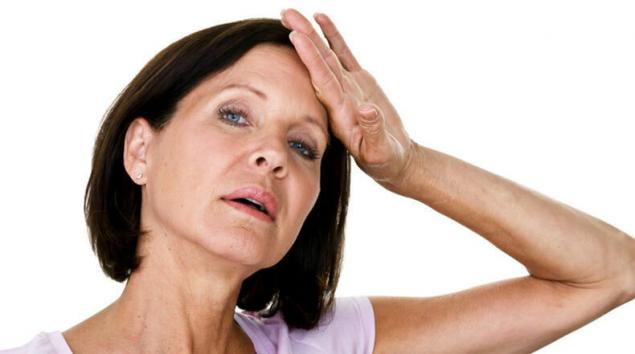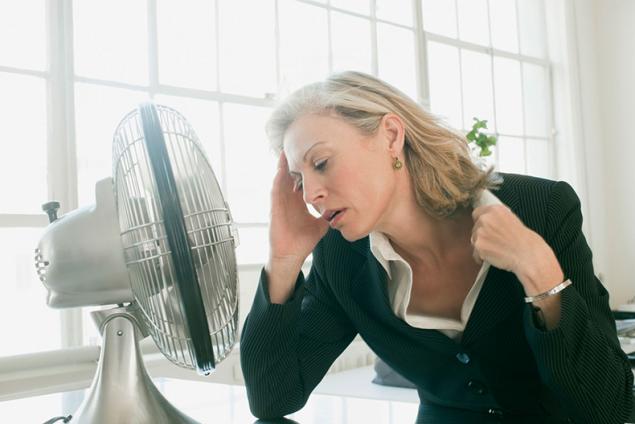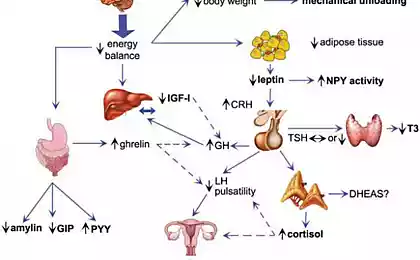587
Signs of menopause
Menopause (or menopause) is one of the stages of a woman's life when the reproductive functions of the body gradually cease due to his hormonal changes. It usually occurs in women older than 40 years, lasting about 10 years.
This is reflected in the fact that gradually end of menstruation. As there may be a number of vegetative-vascular and endocrine dysfunctions: a rush of blood to the upper body and face ("heat"), sweating, irritability and tearfulness, changes in blood pressure, excessive dryness of the skin and mucous membranes, insomnia. Menopause may be accompanied by abnormal uterine bleeding and mental disorders.

Menopause called a stage in a woman's life due to the opposite changes in the reproductive system (the cessation of reproductive function and menstruation). The word "climax" (from the Greek "klimax" ladder) expresses the stages, starting from the beginning of the reproductive functions to their gradual completion.
A woman's life consists of physiological periods, with their anatomical features:
Menopausal syndrome can interfere with normal functioning and disability of women. In connection with the increased life expectancy of women and its Pro-active behavior are the medical and social importance of the problem of irregular flow of menopause.
Causes of menopausal syndromeWith the demise reproductive functions in the body, the following may occur: decreased immunity, frequent autoimmune and infectious diseases, the aging process.
Especially hard when menopause changes female reproductive system. During menopause the ovaries fail to develop follicles, stops ovulation, decreased endocrine activity. Instead of follicles in the ovaries connective tissue forms. This leads to bonding and reducing the size of the ovaries.

Hormonal balance of the body menopause is characterized by the increased content of gonadotropin (follicle-stimulating and luteinizing) hormones and lowering estrogen levels. In the first year of menopause, the content of follicle-stimulating hormone increases during 13-14 times, luteinizing — 3 times, then with a certain reduction.
At menopause change of estrogen synthesis is to stop the production of estradiol and increased production of estrone. The estrogens effect on the uterus, vagina, pelvic muscles, urinary system, mammary glands, brain, arteries and heart, musculoskeletal system, skin, mucous membranes, etc.
The lack of these hormones during menopause leads to malfunction of these tissues and organs. Menopause is an indicator of lack of estrogen and manifests itself in the form of vegetative-neurotic, urogenital disorders, degenerative changes of the skin, high risk of a vascular disease, osteoporosis, mental disorders. As a result of increasing life expectancy in women increases with menopause and estrogendeficiency. As a result increases the probability of occurrence of climacteric syndrome.
Kinds of menopausal disorders,Menopausal syndrome in its symptoms are divided into early, srednerazmernye and pozdnevesennimi signs of menopausal disorders. To early symptoms of menopausal problems include: vasomotor symptoms – hot flashes, headaches, sweating, chills, increase or decrease in blood pressure, palpitations; symptoms of mental disorder — feelings of fatigue, anxiety, irritability, sleepiness, reduced attention, impaired memory, depression, decreased sex drive.
Early symptoms in menopause occur in premenopausal and 1-2 years of menopause. Patients with vascular and psycho-emotional symptoms during menopause often resort to the help of the therapist, taking symptoms of menopause for hypertension, ischemic heart disease or being treated by a therapist from the OCD or depression.
Srednerazmernye symptoms of menopausal disorders manifest as urogenital disorders — dryness of the vaginal mucosa, pain during intercourse, burning, itching, impaired excretion of urine, incontinence of urine; symptoms of the skin — wrinkles, brittle nails, dry skin and hair, hair loss.
Srednerazmernye climacteric syndrome, characterized by atrophic changes of the skin and the genitourinary system, become apparent after 2-5 years from the onset of menopause. Symptoms, urogenital and cutaneous disorders at the menopause usually ineffective.
To pozdnevesennimi symptoms of menopausal disorders are disorders of metabolic processes in the body – osteoporosis, atherosclerosis, Alzheimer's disease, heart disease and blood vessels. Such manifestations of menopause begin 5-10 years from the onset of menopause. the lack of sex hormones during menopause causes a disturbance of the bone structure (osteoporosis) and fat metabolism (atherosclerosis).
Signs of menopauseOn the course of menopause is influenced by hormonal, genetic factors, the body condition of women to the menopause.

Vascular symptoms, also called vasomotor, at the wrong period of climax are 80% women. Such signs of menopause are manifested in the form of sudden "surges" in which dilate the capillaries of the skin on the head, face, neck, breast, increased local skin temperature by 2-5°C and body temperature of 0.5-1°C.
During the "tides" there is a feeling of heat, redness, increased perspiration, quickens the heartbeat. "The hot flashes" lasted 3-5 minutes and occur from 1 to 20 times per day, increasing at night and causing insomnia. When pulmonary vascular disorders, "hot flashes" are from 1 to 10 times a day, with an average of 10 to 20 times. Severe disorders characterized by the number of flushes more than 20 times a day, and accompanied by dizziness, depression, phobias, leading to reduced efficiency.
Asthenoneurotic disorders in menopause occur in 13% of women. They manifest themselves in the form of irritability, tearfulness, feelings of anxiety and fear, changes in olfactory and auditory perception, depression.
These symptoms usually occur before menopause or after its completion, vegetative symptoms continue to occur approximately 5 years from the onset of menopause. Menopausal syndrome is manifested by disorders of the genitourinary system and the occurrence of osteoporosis fractures.
There are atypical forms of development of climacteric disorders: sympatho-adrenal crisis (headaches, increased blood pressure, urinary retention with subsequent polyuria); myocardial — pain in the heart, the cause of which is not possible to identify on ECG. Conventional therapy in this case ineffective; allergic reactions to medications drugs, food, talking about changing reactions of the immune system etc.
During menopause often there are important events in a woman's life: weddings, children, career, retirement. Psychological and social problems exacerbate the course of climacteric syndrome.
Approximately 50% of women with painful period of climax reveals severe violations, 35%-medium and light degree of menopausal disorders is only 15%. In healthy women usually mild menopausal disorders. The patient, who has any of the disease, often suffer from atypical symptoms of menopause.
Chronic diseases, genetic factors, endocrine diseases, Smoking, irregular menstruation in childbearing age, early menopause, sedentary lifestyle, lack of women's childbirth contribute to the development of menopausal disorders.
The identification of menopausal disordersMenopausal syndrome is usually diagnosed based on complaints of patients, appearing as you get closer or menopause. The presence of concomitant diseases often interfere with the diagnosis of menopausal syndrome, weight it causes the development of severe forms.
In this case, the woman is recommended consultation is not only the gynecologist, but other doctors: cardiologist, neurologist, endocrinologist. For the diagnosis of complicated course of menopause analyse the content of FSH and LH hormones, and estrogen in the blood.published
What you need to know about nutrition women 30, 40, 50 and 60 years
50 is not the new 25: fifty, and they can be proud of
Source: makamed.ru/karta-sayta/ginekologiya/hirurgicheskaya-ginekologiya/klimaktericheskiy-sindrom
This is reflected in the fact that gradually end of menstruation. As there may be a number of vegetative-vascular and endocrine dysfunctions: a rush of blood to the upper body and face ("heat"), sweating, irritability and tearfulness, changes in blood pressure, excessive dryness of the skin and mucous membranes, insomnia. Menopause may be accompanied by abnormal uterine bleeding and mental disorders.

Menopause called a stage in a woman's life due to the opposite changes in the reproductive system (the cessation of reproductive function and menstruation). The word "climax" (from the Greek "klimax" ladder) expresses the stages, starting from the beginning of the reproductive functions to their gradual completion.
A woman's life consists of physiological periods, with their anatomical features:
- newborns up to 10 days;
- childhood up to 8 years;
- puberty — 8 — 18;
- childbearing — 18 -45 years;
- of menopause, consisting of: premenopausal (45 years before menopause), menopause (end of menstrual function (49-50 years); postmenopausal woman from 50 to 65-69 years of age;
- age older than 70 years.
Menopausal syndrome can interfere with normal functioning and disability of women. In connection with the increased life expectancy of women and its Pro-active behavior are the medical and social importance of the problem of irregular flow of menopause.
Causes of menopausal syndromeWith the demise reproductive functions in the body, the following may occur: decreased immunity, frequent autoimmune and infectious diseases, the aging process.
Especially hard when menopause changes female reproductive system. During menopause the ovaries fail to develop follicles, stops ovulation, decreased endocrine activity. Instead of follicles in the ovaries connective tissue forms. This leads to bonding and reducing the size of the ovaries.

Hormonal balance of the body menopause is characterized by the increased content of gonadotropin (follicle-stimulating and luteinizing) hormones and lowering estrogen levels. In the first year of menopause, the content of follicle-stimulating hormone increases during 13-14 times, luteinizing — 3 times, then with a certain reduction.
At menopause change of estrogen synthesis is to stop the production of estradiol and increased production of estrone. The estrogens effect on the uterus, vagina, pelvic muscles, urinary system, mammary glands, brain, arteries and heart, musculoskeletal system, skin, mucous membranes, etc.
The lack of these hormones during menopause leads to malfunction of these tissues and organs. Menopause is an indicator of lack of estrogen and manifests itself in the form of vegetative-neurotic, urogenital disorders, degenerative changes of the skin, high risk of a vascular disease, osteoporosis, mental disorders. As a result of increasing life expectancy in women increases with menopause and estrogendeficiency. As a result increases the probability of occurrence of climacteric syndrome.
Kinds of menopausal disorders,Menopausal syndrome in its symptoms are divided into early, srednerazmernye and pozdnevesennimi signs of menopausal disorders. To early symptoms of menopausal problems include: vasomotor symptoms – hot flashes, headaches, sweating, chills, increase or decrease in blood pressure, palpitations; symptoms of mental disorder — feelings of fatigue, anxiety, irritability, sleepiness, reduced attention, impaired memory, depression, decreased sex drive.
Early symptoms in menopause occur in premenopausal and 1-2 years of menopause. Patients with vascular and psycho-emotional symptoms during menopause often resort to the help of the therapist, taking symptoms of menopause for hypertension, ischemic heart disease or being treated by a therapist from the OCD or depression.
Srednerazmernye symptoms of menopausal disorders manifest as urogenital disorders — dryness of the vaginal mucosa, pain during intercourse, burning, itching, impaired excretion of urine, incontinence of urine; symptoms of the skin — wrinkles, brittle nails, dry skin and hair, hair loss.
Srednerazmernye climacteric syndrome, characterized by atrophic changes of the skin and the genitourinary system, become apparent after 2-5 years from the onset of menopause. Symptoms, urogenital and cutaneous disorders at the menopause usually ineffective.
To pozdnevesennimi symptoms of menopausal disorders are disorders of metabolic processes in the body – osteoporosis, atherosclerosis, Alzheimer's disease, heart disease and blood vessels. Such manifestations of menopause begin 5-10 years from the onset of menopause. the lack of sex hormones during menopause causes a disturbance of the bone structure (osteoporosis) and fat metabolism (atherosclerosis).
Signs of menopauseOn the course of menopause is influenced by hormonal, genetic factors, the body condition of women to the menopause.

Vascular symptoms, also called vasomotor, at the wrong period of climax are 80% women. Such signs of menopause are manifested in the form of sudden "surges" in which dilate the capillaries of the skin on the head, face, neck, breast, increased local skin temperature by 2-5°C and body temperature of 0.5-1°C.
During the "tides" there is a feeling of heat, redness, increased perspiration, quickens the heartbeat. "The hot flashes" lasted 3-5 minutes and occur from 1 to 20 times per day, increasing at night and causing insomnia. When pulmonary vascular disorders, "hot flashes" are from 1 to 10 times a day, with an average of 10 to 20 times. Severe disorders characterized by the number of flushes more than 20 times a day, and accompanied by dizziness, depression, phobias, leading to reduced efficiency.
Asthenoneurotic disorders in menopause occur in 13% of women. They manifest themselves in the form of irritability, tearfulness, feelings of anxiety and fear, changes in olfactory and auditory perception, depression.
These symptoms usually occur before menopause or after its completion, vegetative symptoms continue to occur approximately 5 years from the onset of menopause. Menopausal syndrome is manifested by disorders of the genitourinary system and the occurrence of osteoporosis fractures.
There are atypical forms of development of climacteric disorders: sympatho-adrenal crisis (headaches, increased blood pressure, urinary retention with subsequent polyuria); myocardial — pain in the heart, the cause of which is not possible to identify on ECG. Conventional therapy in this case ineffective; allergic reactions to medications drugs, food, talking about changing reactions of the immune system etc.
During menopause often there are important events in a woman's life: weddings, children, career, retirement. Psychological and social problems exacerbate the course of climacteric syndrome.
Approximately 50% of women with painful period of climax reveals severe violations, 35%-medium and light degree of menopausal disorders is only 15%. In healthy women usually mild menopausal disorders. The patient, who has any of the disease, often suffer from atypical symptoms of menopause.
Chronic diseases, genetic factors, endocrine diseases, Smoking, irregular menstruation in childbearing age, early menopause, sedentary lifestyle, lack of women's childbirth contribute to the development of menopausal disorders.
The identification of menopausal disordersMenopausal syndrome is usually diagnosed based on complaints of patients, appearing as you get closer or menopause. The presence of concomitant diseases often interfere with the diagnosis of menopausal syndrome, weight it causes the development of severe forms.
In this case, the woman is recommended consultation is not only the gynecologist, but other doctors: cardiologist, neurologist, endocrinologist. For the diagnosis of complicated course of menopause analyse the content of FSH and LH hormones, and estrogen in the blood.published
What you need to know about nutrition women 30, 40, 50 and 60 years
50 is not the new 25: fifty, and they can be proud of
Source: makamed.ru/karta-sayta/ginekologiya/hirurgicheskaya-ginekologiya/klimaktericheskiy-sindrom























